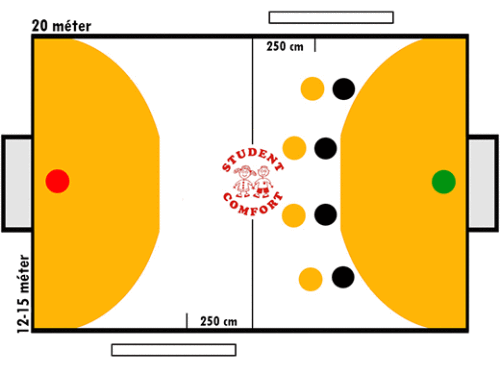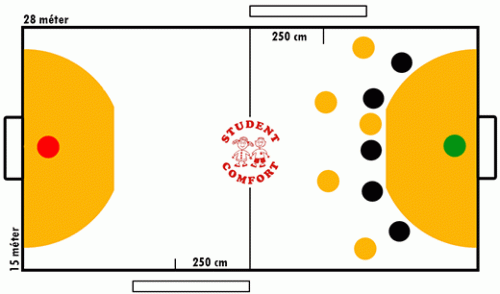Children’s Championship
In the Championship, the competition has two levels.
- Top Class, with minimum 9, maximum 16 teams in each age group
- Regional Class, with minimum 6, maximum 16 teams in each age group
Age groups
U7, U8, U9, U10, U12, U14
Number of teams
- In the Top Championship, in the U10 - U14 groups, minimum 12, maximum 30 players can be entered in the whole season; in the U9 age group, minimum 10, maximum 26 players can be entered.
- In the Regional Championship, in the U10 - U14 groups, minimum 7, maximum 30 players can be entered in the whole season; in the U9 age group, minimum 6, maximum 26 players can be entered; while in the U7 – U8 age groups, minimum 5, maximum 22 players can be entered.
General order of organisation in the Top Championship
In the Top Championship, every match is held in three parts, with the purpose of granting an opportunity to play for every player who is entered for the match.
- In first third, the goal keeper and the six court players to start the game can be selected freely, and their jersey numbers must be marked by circling them in the match report. In the first third, substitutions can be made only in case of injury or suspension.
- When the playing time of the first third is over – at the first interruption of the play (e.g. at a throw-in, a free throw or a goal) – the referees stop the match and order substitutions, without having a break. If the number of players recorded in the match report makes it possible, a complete set of substitutions is made. If a complete set of substitutions is not possible, due to the number of players entered for the match or because of injuries, the players who stay on court in the second third are selected from those who scored the least goals in the first third. The substitution of the goalkeeper is also mandatory, but in the second period the goalkeeper can also be someone who was a field player in the first period, and the goalkeeper of the first period can also be a field player in the second period, but that is not mandatory. In the second third – as in the first – substitutions can be made only in case of injury or suspension. An injured player can be substituted by the field player who scored the least goal in the first third, or by the goalkeeper. After the substitutions are arranged, the second period follows from the playing situation where the match was interrupted at the end of the first period, without changing the sides of the court. If there are suspensions in effect at the end of the first or second period, the team that committed the fouls must serve the rest of the suspensions (playing with fewer players until the end of the suspensions).
- If the substitution is due to injury, the entering player can be freely substituted again with the injured player. In the second third, in case of injury, either a player who has so far not entered, or has scored the least goals can enter the court.
- After the playing time of the second third is over, there is a 5-minute break.
- In third period, the players entering the court can be freely chosen from the players entered for the match; substitutions can be made according to the general rules.
- The final result of the match is the total sum of the results of the three thirds.
Playing time in the Top Championship
- U14 age group: 3x15 minutes – suspension 2 minutes, time out 3X1 minute
- U12 age group: 3x12 minutes – suspension 2 minutes, time out 3X1 minute
- U10 age group: 3x10 minutes – suspension 2 minutes, time out 3X1 minute
- U9 age group: 3x10 minutes – suspension 2 minutes, time out 3X1 minute
Playing time in the Regional Championship
- U14 age group: 2x20 minutes – suspension 2 minutes, time out 2X1 minute
- U12 age group: 2x15 minutes – suspension 1 minute, time out 2X1 minute
- U10 age group: 2x10 minutes – suspension 1 minute, time out 2X1 minute
- U9 age group: 2x10 minutes – suspension 1 minutes, time out 2X1 minute
- U8 age group: 2x10 minutes – suspension 1 minutes, time out 2X1 minute
- U7 age group: 2x10 minutes – suspension 1 minutes, time out 2X1 minute
Size of the ball
- U14 age group: ball size 2
- U12 age group: ball size 1
- U10 age group: ball size 0
- U9 age group: sponge material (soft ball), 15-16 cm in diameter, 140-170 g
- U7-U8 age group: sponge material (soft ball), 13-14 cm in diameter, 100-130 g
General technical requirements
In the U10-U14 age groups of the Championship – in case of complete teams, regarding the number of players – man-marking (man-to-man) defence MUST be applied in the first part of every third or half; it is forbidden to apply a defence lining up on the 6-meter line.
It is forbidden to apply a combined defence system in any age group or any period of the Championship.
General rules of soft-ball handball in the U7-U8 age groups
- Size of playing field, and its markings:
The playing field is a rectangular area that is 20 metres in length and 10-15 metres in width. The zone in front of the goal is a semi-circular area that is 5.5 metres in radius; two arcs are drawn around the two posts and connected by a straight line parallel the goal. The base lines and the side lines are continuous lines that are 5 centimetres in width. The substitution line is 35-centimetre part, 250 centimetres from the half line, to both directions.
- Size and form of the goal:
The goal is at the centre of the base line, 150-160 centimetres high and 240-250 centimetres wide.
- Number of players:
4 field players and 1 goalkeeper may stay in the playing field at the same time. The goalkeeper must not play in the field as a sixth field player.
- The rules of the process of the play:
At every throw-off, the defensive team must go back and align in front of their goal zone; they can get further from it and start close man marking only afterwards. The players who do not possess the ball can be followed only by the body; they must not be “embraced” by the arms in close man marking. At the fixed throwing situations (throw-in, free throw, penalty throw), the defending players must be at least 1 metre away from the throwing player. At a free throw, the players of the offensive team must be at least 1 meter away from the line of the opponent’s D-zone (defence zone or goal zone). The penalty throw must be performed from the line of the D-zone (5.5 metres).

General rules of soft-ball handball in the U9 age group
- Size of playing field, and its markings:
The playing field is a rectangular area that is 28 metres in length and 15 metres in width. The zone in front of the goal is a semi-circular area that is 6 metres in radius; two arcs are drawn around the two posts and connected by a straight line parallel the goal. The base lines and the side lines are continuous lines that are 5 centimetres in width. The substitution line is a 35-centimetre part, 250 centimetres from the half line, to both directions.
- Size and form of the goal:
The goal is at the centre of the base line, 150-160 centimetres high and 240-250 centimetres wide.
- Number of players:
5 field players and 1 goalkeeper may stay in the playing field at the same time. The goalkeeper must not play in the field as a sixth field player.
- The rules of the process of the play:
At the fixed throwing situations (throw-in, free throw, penalty throw), the defending players must be at least 1 metre away from the throwing player. At a free throw, the players of the offensive team must be at least 1 meter away from the line of the opponent’s D-zone. The penalty throw must be performed from the line of the D-zone (6 metres). The team scoring a goal must return to the line of their own D-zone.

The competition system of the Soft-ball handball Class
Sponge, as a soft and flexible material, can provide excitement for the smallest children, who instinctively feel the fun of movement; handling it causes them no pain whatsoever. The magic of soft balls provides the easiest way to arouse the desire to attend physical education and to do sports regularly. Soft-ball handball, which started decades ago, also takes advantage of this opportunity, giving a chance to realise two goals at the same time. On the one hand, it can arouse the desire to move and do sports regularly; on the other hand, it can help to evoke interest in a particular sport, that is, handball.
Soft-ball handball makes it possible to learn the main rules of handball and to acquire the technical elements more easily. Through relatively rapid successes, it has a positive effect on the development of children and their attachment to the sport. Soft-ball handball is open for nursery school children and lower primary school children too. It is also a help for their teachers that the magic of the small ball makes the physical education classes more interesting and enjoyable.
At the soft-ball handball matches of the smallest children, the rules are secondary. The main objective is that the game should be similar to handball, in a flexible manner. However, justice and the education of discipline and order should be fully realised.
The structure of the National Soft-ball Handball Competition System
In the 2013-14 season, the Hungarian Handball Federation, according to the needs and possibilities, announces a regional, open competition for the U7, U8 and U9 age groups (from now on: Soft-ball Handball Competition System), where there is no official result taken, shown or announced. The objective is that for every team entering – in addition to the close availability – there are at least 5 match days both in the autumn and the spring seasons. Between the matches, contests of penalty throwing or other skills should be organised.